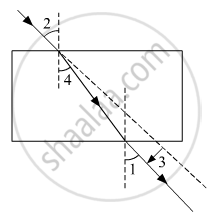Advertisements
Advertisements
प्रश्न
State two effects produced by the scattering of light by the atmosphere.
उत्तर
The scattering of light by the atmosphere makes
(a) the sky appear blue during the daytime
(b) the sun appear red at sunrise and sunset
APPEARS IN
संबंधित प्रश्न
What is atmospheric refraction? Use this phenomenon to explain the following natural events:
Twinkling of stars
Draw diagrams to illustrate your answers.
The correct sequencing of angle of incidence, angle of emergence, angle of refraction and lateral displacement shown in the following diagram by digits 1, 2, 3 and 4 is:

(a) 2, 4, 1, 3
(b) 2, 1, 4, 3
(c) 1, 2, 4, 3
(d) 2, 1, 3, 4
Name two effects produced by the atmospheric refraction.
Fill in the following blank with suitable word:
We can see the sun about ................ minutes before the actual sunrise and about ................ minutes after the actual sunset because of atmospheric ................
Due to atmospheric refraction of sunlight, the time from sunrise to sunset is lengthened by about:
(a) 6 minutes
(b) 2 minutes
(c) 4 minutes
(d) 5 minutes
A student claims that because of atmospheric refraction, the sun can be seen after it has set, and the day is, therefore, longer than if the earth had no atmosphere.
What does the student mean by saying that the sun can be seen after it has set?
What causes the scattering of blue component of sunlight in the atmosphere?
Which of the following is not caused by the atmospheric refraction of light?
(a) twinkling of stars at night
(b) sun appearing higher in the sky than it actually is
(c) sun becoming visible two minutes before actual sunrise
(d) sun appearing red at sunset
A star sometimes appears brighter and some other times fainter. What is this effect called? State the reason for this effect.
The air layer of the atmosphere whose temperature is less than the hot layer behave as optically:
